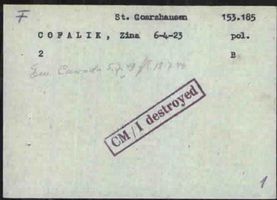Variation
Page of
- Reference


This variation of the IRO card comes from the British occupation zone. Like the IRO cards from the French occupation zone, only basic information is known about this card. However, the stamp and data on the card indicate that IRO employees probably created these cards from July 1947 for DPs who were living in the British occupation zone. The employees noted the DPs’ personal details on the cards: their name, birth date, a registration number, citizenship and place of birth. They also wrote how much support the DP was receiving from the IRO, namely, whether they were “eligible” and, if so, to what extent. On the back of the cards, there is usually information about the CM/1 application and the question of whether IRO employees had destroyed this form or not. This could happen when the IRO was no longer responsible for caring for the DPs because they had emigrated, returned to their country of origin or decided to stay in Germany.
One special feature of these cards is the “discharged to” stamp which can be found on the front or back of the cards. This stamp means that the person worked for the British armed forces.
This variation of the IRO card comes from the British occupation zone. Like the IRO cards from the French occupation zone, only basic information is known about this card. However, the stamp and data on the card indicate that IRO employees probably created these cards from July 1947 for DPs who were living in the British occupation zone. The employees noted the DPs’ personal details on the cards: their name, birth date, a registration number, citizenship and place of birth. They also wrote how much support the DP was receiving from the IRO, namely, whether they were “eligible” and, if so, to what extent. On the back of the cards, there is usually information about the CM/1 application and the question of whether IRO employees had destroyed this form or not. This could happen when the IRO was no longer responsible for caring for the DPs because they had emigrated, returned to their country of origin or decided to stay in Germany.
One special feature of these cards is the “discharged to” stamp which can be found on the front or back of the cards. This stamp means that the person worked for the British armed forces.

Questions and answers
- What are considered variations in the e-Guide?
The e-Guide distinguishes between main cards and variations. The reason for this is that there are sometimes different versions of a single type of document that can vary significantly.
The documents referred to as main cards in the e-Guide are standard documents that were used especially frequently in concentration camps, DP camps, and for the registration of forced laborers, and about which a good deal of information is available. The Arolsen Archives also hold variations of these documents, however, which served the exact same purpose as the corresponding main cards, but which look different. There are various reasons for this: Some camps used their own individually produced cards instead of the standard versions. In many other cases, individual cards and forms were used before the introduction of standardized pre-printed forms.
- Do you know more about the document?
If you have any additional information about this document or any other documents described in the e-Guide, we would appreciate it very much if you could send your feedback to eguide@arolsen-archives.org. The document descriptions are updated regularly – and the best way for us to do this is by incorporating the knowledge you share with us.